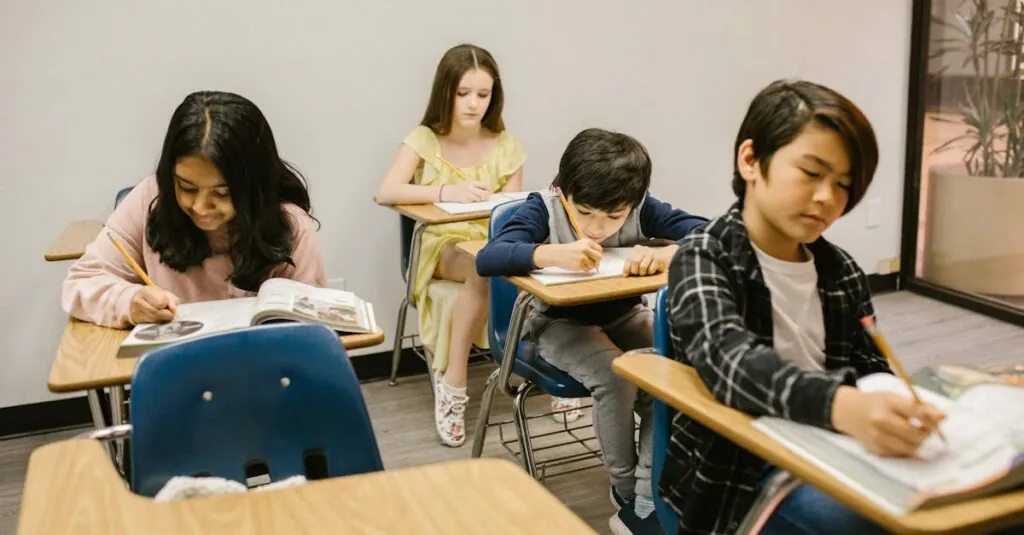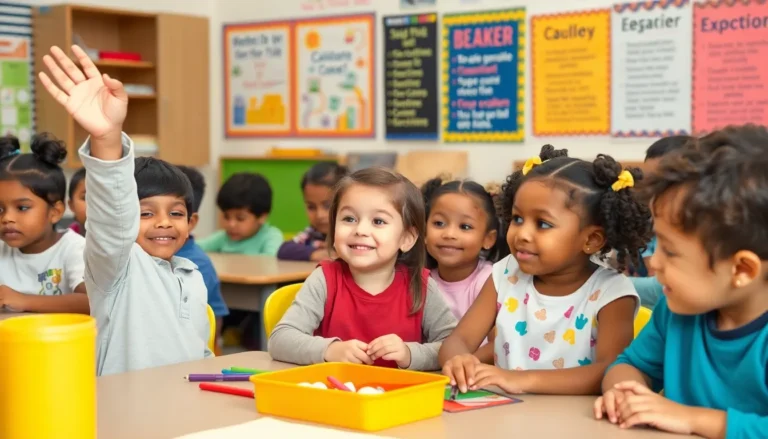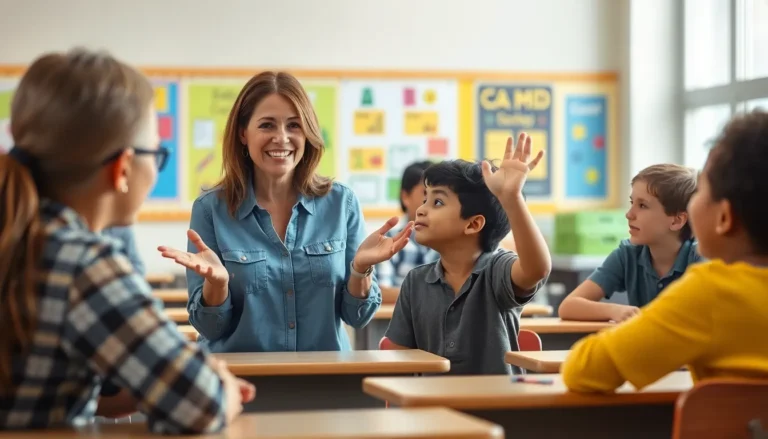Table of Contents
ToggleEvery parent hopes their child’s playground experience is filled with laughter and friendship, but sometimes, it turns into a battleground. Playground bullying among elementary pupils is a serious issue that can leave lasting scars. It’s not just a harmless game of tag gone wrong; it’s a complex social dynamic that needs attention.
Understanding Playground Bullying Among Elementary Pupils
Playground bullying manifests in various forms, including physical aggression, verbal harassment, and social exclusion. Statistics indicate that around 30 percent of elementary pupils experience bullying during school hours, significantly impacting their emotional development. Victims often face anxiety, depression, and decreased academic performance, highlighting the issue’s severity.
Teachers and parents should recognize the signs of playground bullying. Common behaviors include reluctance to participate in activities, sudden changes in friendship patterns, and frequent complaints about pain or illness. Awareness and understanding can empower adults to address these situations effectively.
Social dynamics play a crucial role in bullying behavior. Some children, eager to fit in, might participate in bullying as a means of gaining peer approval. Observers, often silent, can inadvertently reinforce the behavior by not intervening. Encouraging positive interactions among pupils can create a more inclusive environment.
Interventions at the community and school levels are essential to combat playground bullying. Programs that focus on empathy training and conflict resolution equip children with the tools necessary to handle conflicts constructively. Leadership from adults in implementing these programs fosters a safe atmosphere.
Collaboration among educators, parents, and students promotes awareness. Regular discussions about empathy and respect can build a supportive culture. Schools implementing anti-bullying initiatives report a decrease in incidents and an increase in student well-being.
Finally, open communication channels between students and adults reinforce that bullying is unacceptable, making it easier for victims to seek help. Establishing trust creates a supportive network, ensuring that every child feels safe and valued in their school environment.
Causes of Playground Bullying
Playground bullying stems from a variety of causes that can significantly impact elementary school children. Understanding these causes is crucial for effective intervention.
Social Dynamics
Social dynamics play a significant role in playground bullying. Children often seek peer approval, which may motivate some to engage in bullying behavior. Dominance tactics may emerge as a way to establish social status, making victims feel isolated and powerless. By remaining silent, bystanders can inadvertently perpetuate this cycle, giving bullies a sense of power. Peer groups frequently influence actions, leading some children to conform to bullying norms as a means of fitting in. Recognizing these social factors provides insight into how to effectively address bullying in school environments.
Psychological Factors
Psychological factors contribute to the prevalence of playground bullying. Children who experience insecurity or low self-esteem may engage in bullying to mask their discomfort. Traumatic experiences and learned behaviors from home can further exacerbate these issues. Anxiety can drive some kids to assert control through aggression, often targeting those perceived as weaker. Understanding these psychological triggers is essential for developing intervention strategies that address the root causes of bullying. Without awareness of these factors, addressing playground bullying may prove challenging for educators and parents alike.
Effects of Playground Bullying
Playground bullying causes significant harm, affecting children’s emotional well-being and behavior. The repercussions can last far beyond the schoolyard.
Emotional Impact on Victims
Victims often experience anxiety and depression. Feelings of isolation and low self-esteem frequently accompany these emotional challenges. Reports indicate that bullied children may withdraw from social interactions, affecting their ability to form friendships. Academic performance tends to decline as a result of emotional distress, leading to a cycle of difficulty in both social and academic environments. Understanding these emotional scars is vital for creating supportive interventions.
Consequences for Bullying Behavior
Children who engage in bullying behavior face serious long-term consequences. They may develop patterns of aggression that persist into adulthood. Research shows that these individuals often struggle with relationships and authority figures. Engaging in bullying can result in disciplinary actions at school and difficulties in maintaining friendships. Moreover, many of these children risk becoming isolated as peers reject aggressive behavior. Addressing these underlying issues is critical for fostering a more positive school environment.
Prevention Strategies
Effective prevention strategies involve the collaboration of parents, guardians, and schools to create a supportive environment. Addressing playground bullying requires proactive measures at multiple levels.
Role of Parents and Guardians
Parents and guardians play a crucial part in preventing playground bullying. Open conversations about bullying can help children understand its impact, encouraging empathy and respect for others. Observing children’s behavior during playtime informs adults about potential issues. Active involvement in school activities demonstrates support, reinforcing positive social interactions. Encouraging kids to share their feelings helps identify bullying situations early. Responding calmly and constructively when children disclose experiences fosters trust, ensuring they feel comfortable seeking help when needed.
School Interventions
Schools must implement effective interventions to combat playground bullying. Establishing clear policies against bullying sets expectations for student behavior. Educators should incorporate anti-bullying programs that teach emotional intelligence and conflict resolution skills. Providing training for staff raises awareness of bullying dynamics, enabling timely response to incidents. Creating safe spaces for students to express concerns enhances communication between peers and adults. Regular workshops and assemblies promote a culture of kindness and inclusion, empowering students to stand up against bullying behavior. These comprehensive strategies contribute to a safer and more supportive school environment.
Addressing playground bullying among elementary pupils is crucial for fostering a safe and supportive environment. By recognizing the signs and understanding the underlying social dynamics, parents and educators can play a vital role in prevention. Implementing effective strategies such as open communication and empathy training can significantly reduce incidents of bullying.
Creating a culture of kindness and inclusion not only benefits victims but also helps those who engage in bullying behavior. It’s essential to work together as a community to ensure every child feels valued and secure. With collective efforts, schools can become places where all children thrive emotionally and academically, free from the shadows of bullying.





